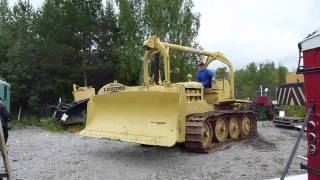Monday, 22 December, 2025г.
















Где искать: по сайтам Запорожской области, статьи, видео ролики
пример: покупка автомобиля в Запорожье
Classic earthmoving machinery: The Vickers Vigor
The Vickers Vigor: an overview by Richard Campbell As a result of their experience manufacturing tanks during WWII, Vickers-Armstrong of Newcastle, England decided to build a track-type tractor to take on the Americans. BY RICHARD CAMPBELL A successful product would be a boost to Britain’s war ravaged economy and also stem the flow of imported tractors which used up valuable overseas funds. Design studies began in 1946 and by 1950 a prototype had been assembled and tested to the satisfaction of the engineers although actual production of the Vickers model VR180 (soon to be known as the ‘Vigor’) did not commence until 1952. The design of the tractor was unique – the VR180 resembled no other track-type tractor available anywhere in the world at that time. The machine was also very innovative in a number of areas, displaying some very advanced ideas for the time. All the components were of British design and manufacture including the matched line of attachments – blades, cable control units, winches, hydraulic controls, towed scrapers, etc. Considered to be a D8-sized tractor in its day, the Vickers Vigor was powered by a Rolls-Royce C6SFL, six-cylinder, supercharged, inline diesel engine, rated at approx 160 horsepower at 1800 rpm. A fairly rugged and reliable engine, the C6SFL featured dry sump lubrication, direct electric starting and a viscous silicone torsional damper along with a fair quantity of aluminium castings in place of cast iron. The dry sump feature allowed constant full pressure lubrication of all the vital engine internals even at extreme operating angles. Euclid (Great Britain) also favored this powerplant and utilised it in a number of its machines. Coupled to the diesel was a six-speed constant mesh transmission of Vickers’ own design, driven through an 18 inch single plate Borg & Beck clutch. Compared to its contemporaries, who could make about 5.5 miles per hour in top gear, the Vigor was a racehorse, with a top speed of almost 10mph. By far the most radical feature of the Vigor was its undercarriage. This was heavily influenced by the company’s experience in tank design, and incorporated a sprocket and three idler-sized road wheels per side with no carrier rollers. These units were all fully articulated and allowed the Vigor to literally envelop obstacles in its path without lifting track off the ground and consequently losing traction. A comparison could be drawn in the design of Caterpillar’s bottom rollers on their hi-drive track type tractors, which operate in a similar ground hugging fashion. The entire undercarriage was isolation mounted via rubber bushings to absorb shock including the sprockets. Normal track chain would, of course, not fit the Vigor due to the unique design, so Vickers made its own. This was a rather complicated affair and had quite a few more parts than a usual track assembly does. Included were rubber washers in the link bushes to exclude dirt. The tractor was manufactured in two sections – a front hull, which contained the engine and clutch, and a rear hull, which held the transmission and final drives. Literature of the day stated that the machine could be separated for maintenance by two trained technicians in two hours. For the operator, the Vigor had a wide, comfortable seat; great visibility and a very clutter-free deck. A foot throttle/decelerator was also a feature of the Vigor. As production progressed several options were made available to purchasers. These included a torque converter drive option and replacement of the Rolls-Royce engine with a Cummins model NT6-BI, six-cylinder, turbocharged diesel, rated at 210 horsepower. Most purchasers preferred the Rolls-Royce. The VR180 Vigor was manufactured up until 1961 when mounting development costs, indifferent performance, declining sales and the American juggernaught finally laid the machine to rest. Vickers attempted a comeback with a somewhat refined version of the Vigor known as the VR110 Vikon but just over 20 were produced before these also went the way of the Vigor. Thanks for checking out NZ Contractor magazine's Vickers Vigor clip. These clips are made from images published in conjunction with classic machine reviews at http://www.contractormag.co.nz/category/classic-machines/ Captions and associated images have all been uploaded to Pinterest https://nz.pinterest.com/ContractorMag/ Author Richard Campbell has sourced these images; Richard also blogs at http://www.contrafedupdate.me -~-~~-~~~-~~-~- Remember this company? https://www.youtube.com/edit?o=U&video_id=YOAp53GXLcM -~-~~-~~~-~~-~-
Теги:
Vickers The VR180 Model VR 180 vintage machinery The VR180 Vigor Diesel tractors vickers tractors classic earthmoving earth moving in nz earthmoving machines vickers utility tractor vicars vigor vikers vigor the vigor vigor tractors the vigor tractor the Vikon vickers bulldozer vickers vigor vickers 180 vickers dozer vickers armstrong vickers vigor bulldozer vickers vigor at work the vickers classic earthmoving machinery earth moving machines
Похожие видео
Мой аккаунт


 У вашего броузера проблема в совместимости с HTML5
У вашего броузера проблема в совместимости с HTML5


